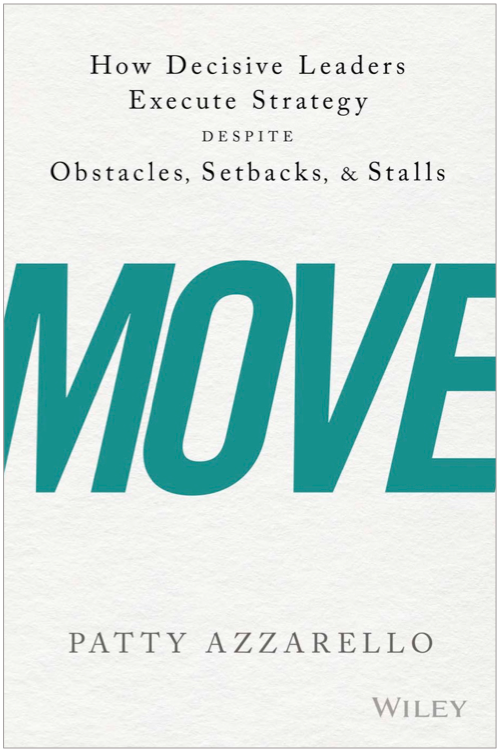
What Good General Managers Do series
Your strategy is only good if you execute it
Think of if this way…
Greatness of Strategy = Strategy * Execution
If execution is zero, greatness is zero.
ONCE is not enough…
Simply telling people what is important will cause not the organization to start doing what is important.
I have seen this many times. Executives will communicate the new strategy at a big all-hands meeting with ice cream…
Then they expect that not only did everyone actually hear the strategy, but that they were listening carefully, internalized it, know what they need to do personally to act on it, know how to optimize it with regard to their current work, and will actively do the right things to implement their piece of it.
(This never happens…)
How to get your team listening, motivated and taking action
As a general manager, you need all your people to be ready, willing and able to implement the new strategy. You can’t do it without them.
You need to invest in recruiting them.
You need to give them insight, permission and support to take action on strategic initiatives.
These are the steps I have used with my own teams to get them to take action on the business strategy.
This works. Please plagiarize it.
1. Create an ongoing communication plan
Part of implementing your strategy is communicating about it continuously over the entire course of executing it.
Remember, all the employees were not in on the planning.
You have been thinking about this strategy, and the importance of it, for a long time. You have evaluated alternatives and tested assumptions.
You have had a lot of time, sleepless nights, showers, and traffic jams, to think through the plan, to personalize it and internalize it.
Why do you think your people can internalize it after hearing it one time? You didn’t.
2. Remember they are not really listening
Just because you talk doesn’t mean your people automatically listen.
You need to break in, and make your message more important than what they already care about.
The other thing working against you is that people hate change.
People are threatened by change.
They already feel too busy. They fear this new thing will mean even more work, or that their job will somehow get worse, or maybe even go away because of it.
Also, they will have a tendency to think that you are not serious, because they have heard about many new strategies and initiatives in the past, and nothing ever happens… So why should they bother investing in this one? It won’t matter anyway.
I’ll just endure this new strategy meeting, smile, nod, eat the ice cream, and go back to work…
3. Set context:
What made you choose to change something or do something in the first place? Say so!
As the leader, you live in the big picture. But the people in your organization live in the work.
You need to communicate the big picture and the sell the business reasons why your strategy is important, and why new things must be done.
You need to talk about the business pressures and drivers that caused you to develop the strategy. You need to make it vividly clear that the new way is vastly better than the current way, and why.
If it doesn’t seem way better, it’s probably not a very good strategy to begin with.
4. What is NOT changing
This may be the most important part of your message. What is NOT changing is the key that unlocks people’s ability to listen to something new. It lets them start listening from a position of “I already know something”.
No one can take on brand new information if it is all brand new information.
By saying “here are the things that are not changing”, you give them a place to stand.
You give them a fighting chance of opening up to receive new information. Never skip this part.
Even if everything is changing, find something to talk about that stays the same. You greatly increase your ability to execute if you do not skip this step.
5. Thank them for the work so far
Don’t get so excited about the new stuff that you forget to thank people for the work that got you to this point. It really pisses people off to hear you go on about the great new strategy and feel like their past 3 years of hard work doesn’t count for anything.
Even if the strategy requires you to throw away 100% of the work that has been done to this point, that is not a reason NOT to say thank you.
“Thank you for the hard work that got us to this point” is another door-opener to get people ready to listen.
6. And now, for something completely different.
Finally! Now you can talk about the new strategy.
Tell people what you will to do, on what scale, why you will win, and how you will measure it.
Be clear about the top few “Ruthless Priorities” to implement it.
7. Keep it simple
Make sure you can fit the basic points of your strategy on one slide.
Even better, test yourself by telling your strategy to a colleague that has not heard it before, one time, and then ask them to repeat it back to you. You should also be able to explain it your mother.
If you don’t pass this test, your message is too complicated.
We all have a way of overcomplicating our strategies. You should be able to communicate your strategy by answering a few simple questions. I coach CEO’s and GM’s on this all the time.
Let’s update the equation…
Greatness of Strategy =
Strategy*Execution
________________
Complexity
(Complexity >=1, 1 is best)
The more complicated your strategy, the less likely it will stick.
8. Here is what the new thing means to you…specifically
Anticipate people’s questions and address them head on, in their words.
Don’t use lofty, impressive sounding business-speak.
Don’t avoid the real and uncomfortable questions people have.
One time when I was a GM at Hewlett Packard and had to greet the employees of a company we were acquiring for the first time. I said, “Hello”, you all know why we are here, I’ll get to all that in a moment, but I know what you are all thinking is:
“Do I still have a job? When will I know? and if I still do have a job, is it one that I will like? I didn’t choose to work in a big company, and now I am stuck in a big company…if I even have a job. What will happen to me?”
It’s not hard to know what questions people would have. And if you don’t know, ask. Find out. And make sure not to clean them up. Answer the questions in the same style and language they were be asked.
9. Communicate 21 times
There is a well tested marketing principle that says: for your audience to understand and internalize your message well enough to act on it, it takes them hearing or seeing your message seven times. And for every one time they see or hear it, they have to be exposed to it three times. That’s 21 times!
I can tell you without question or hesitation, 21 times is not overkill.
If this amount of marketing communication is necessary for someone to buy a digital camera or take a vacation, at least this much it is certainly necessary to sell a business strategy.
You need to be unfailingly consistent in your communications.
Only when you are mind-numbingly bored with talking about your strategy will your organization really know you are serious and feel confident about acting on it.
There is a very funny story in my book RISE… about this 21-times rule. (it’s in the chapter on Ruthless Priorities.) If you haven’t read RISE yet, there is a lot more information about how to communicate to your team, your peers and your management, so you get stuff done.
10. Create a new social norm
Even if you do everything right, and communicate over and over again, the gravitational pull of going back to the old way is really strong.
The trick is to not only communicate about the new strategy from the top, but to get all of your people communicating about the new strategy amongst themselves.
You need to make the new way of working to implement the new strategy a part of the social fabric of your organization, by getting people at all levels talking about it.
Get your people talking to you and each other about what is expected, and how it is going.
How are they doing? What is working? What is challenging? Where are the success stories? How have people made time to focus on the new things?
Final thought
There seems to be a natural tendency in organizations to focus on strategic planning and then not focus on communicating. Both are necessary.
Was this useful?
If you found this article useful, please help me share it (share links below) with others and encourage them to subscribe.
About Patty
Patty Azzarello is an executive, best-selling author, speaker and CEO/Business Advisor. She became the youngest general manager at HP at the age of 33, ran a billion dollar software business at 35 and became a CEO for the first time at 38 (all without turning into a self-centered, miserable jerk)
You can find Patty at www.AzzarelloGroup.com, follow her on twitter or facebook, or read her book RISE…How to Be Really Successful at Work AND Like Your Life.
Subscribe for free
If you found this article useful, you can subscribe to this blog for free and get updates in your email or RSS reader.
Get Facebook Updates.
Click “Like” to get more great business leadership updates on Facebook
CEO’s and General Managers
CEO’s and General Mangers can learn about Patty’s work helping businesses put their Strategy into Action™ and develop their leaders here.
What Good General Managers DO
This is fifth article in my series of
What Good General Managers DO
More aritlces in the series so far:
People
Listen: Stay Connected to Reality
Why people don’t do what you say (today)
Process
The Gap Between Committed and Done
Failure & Motivation
Profit
Strategic Planning and Other Delusions



